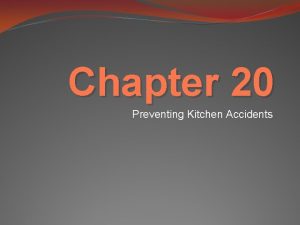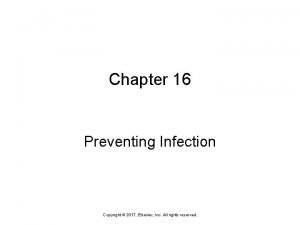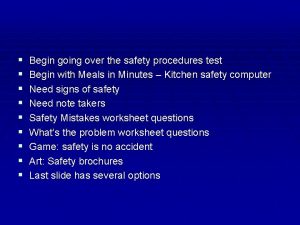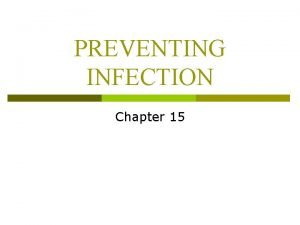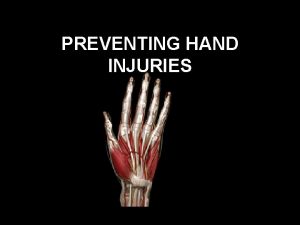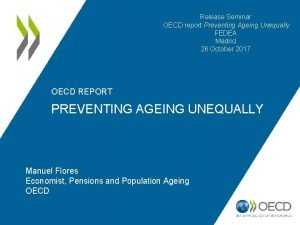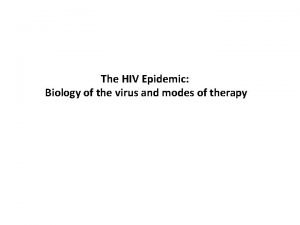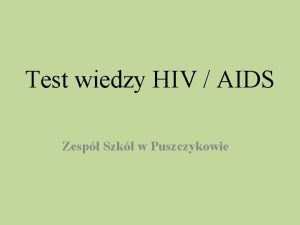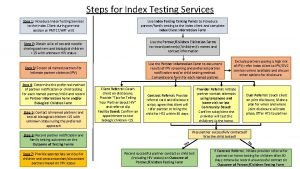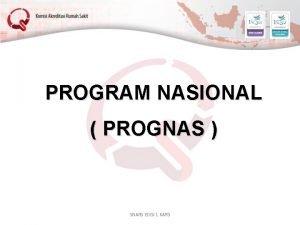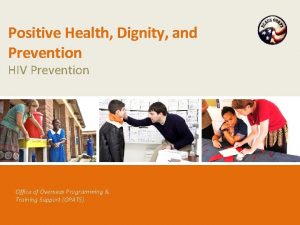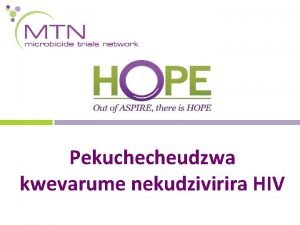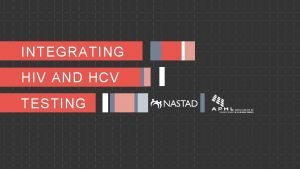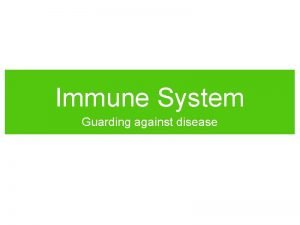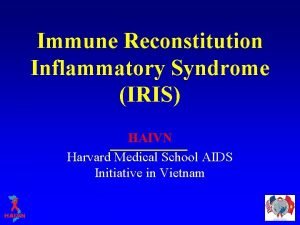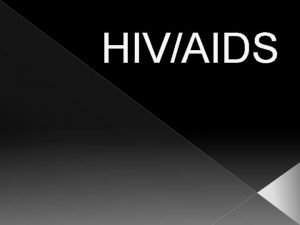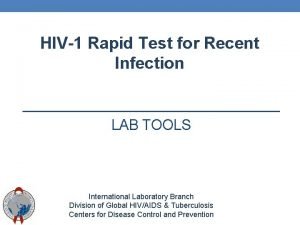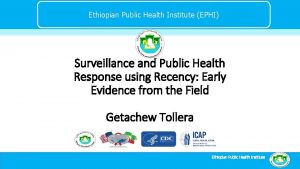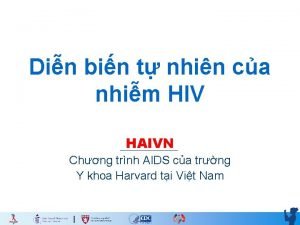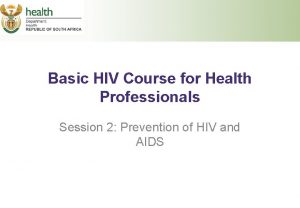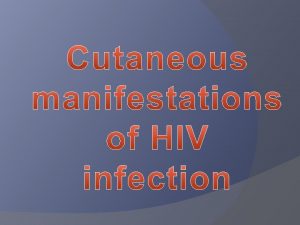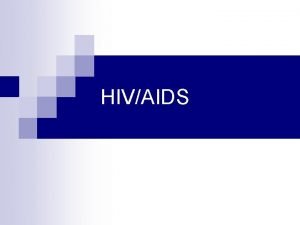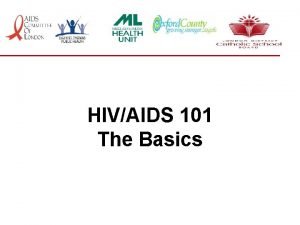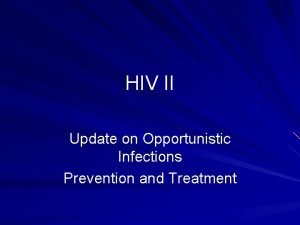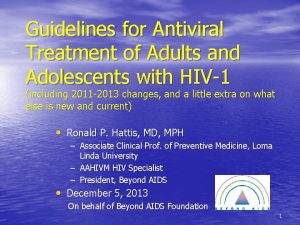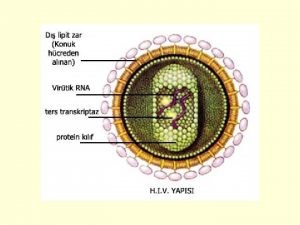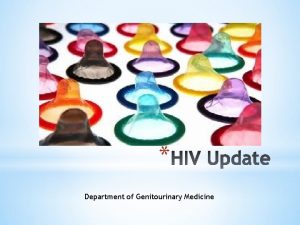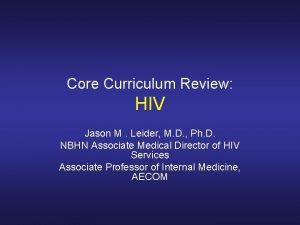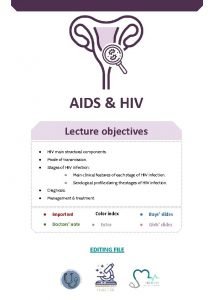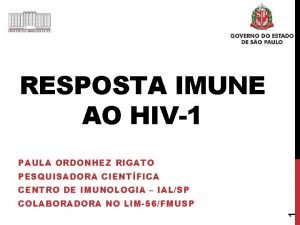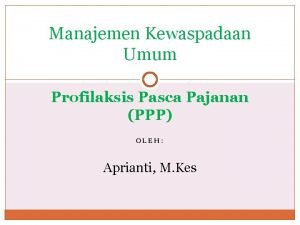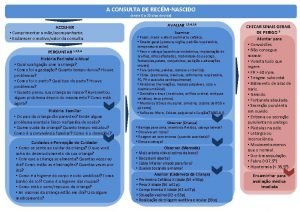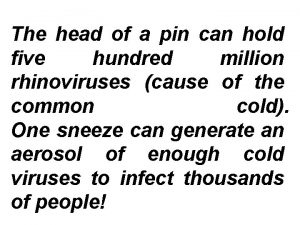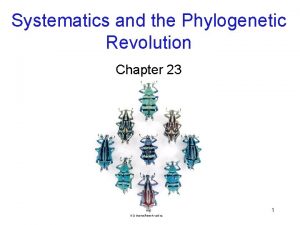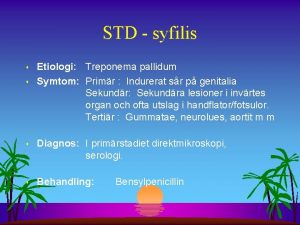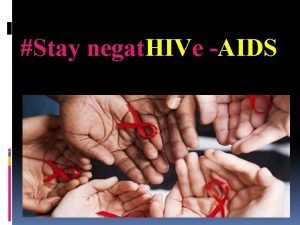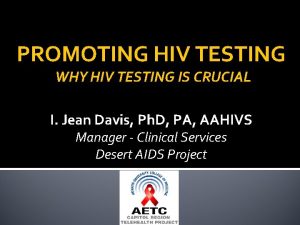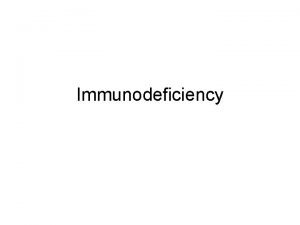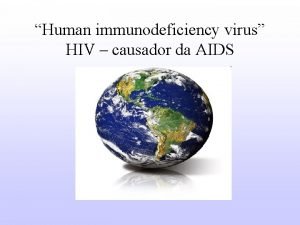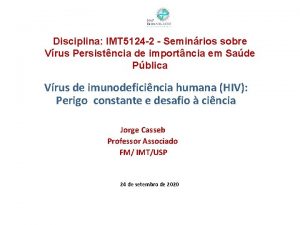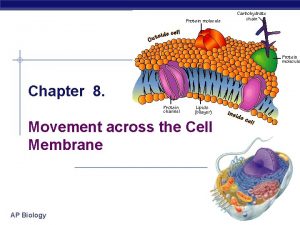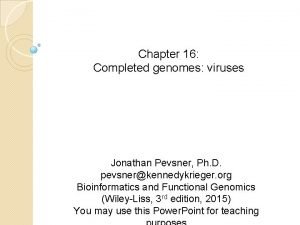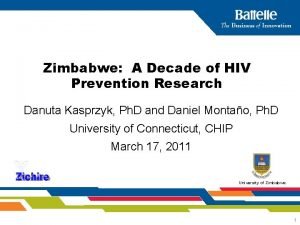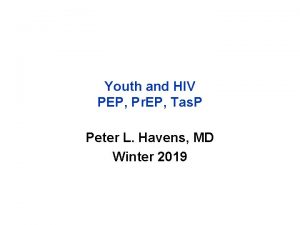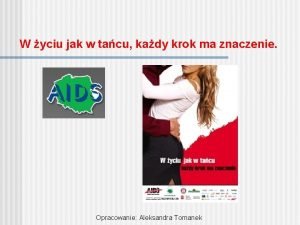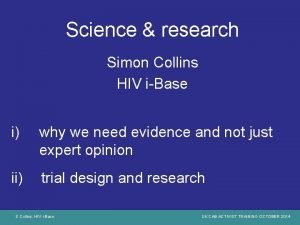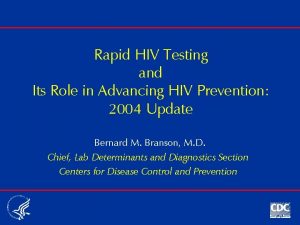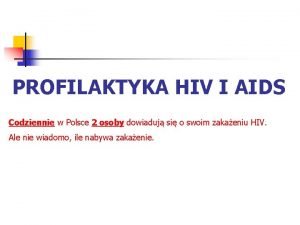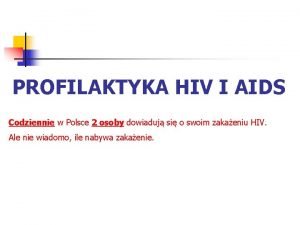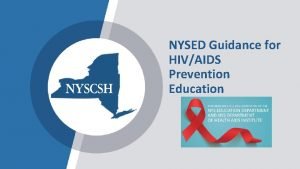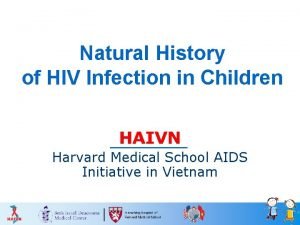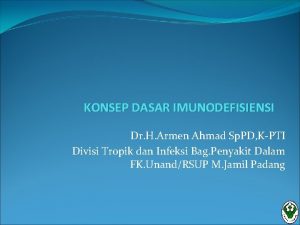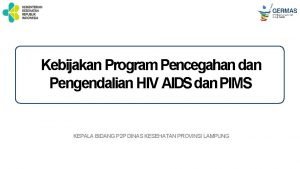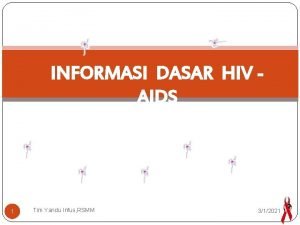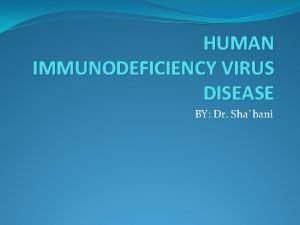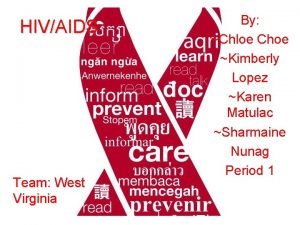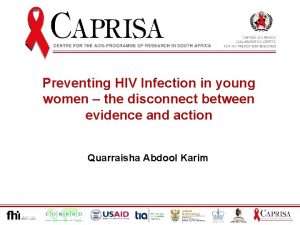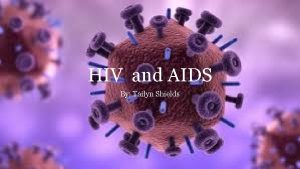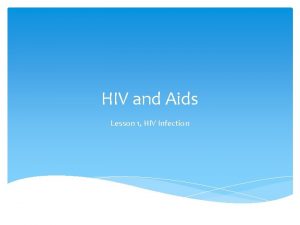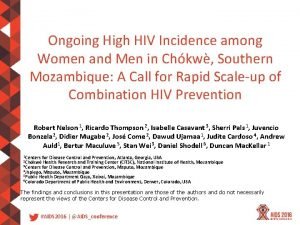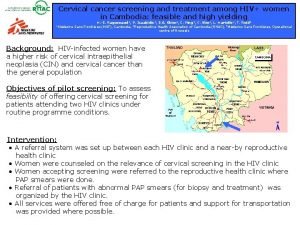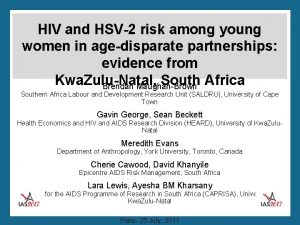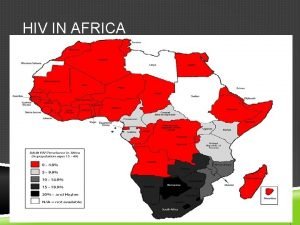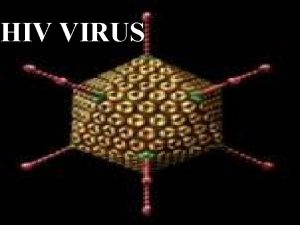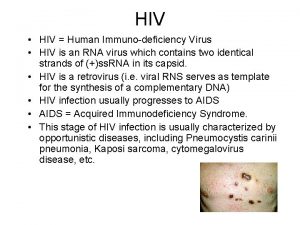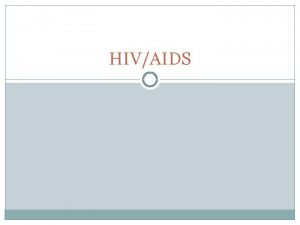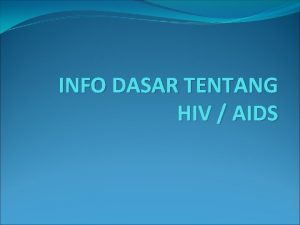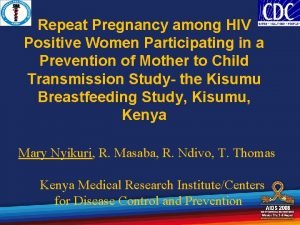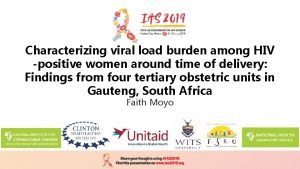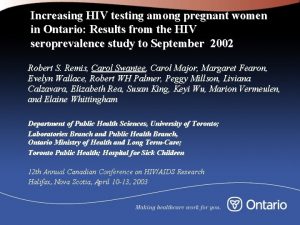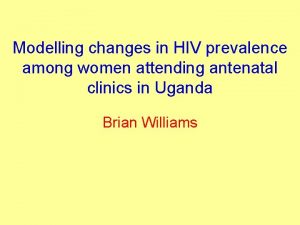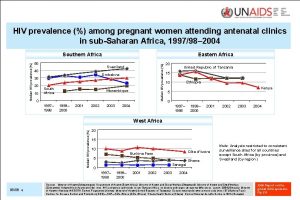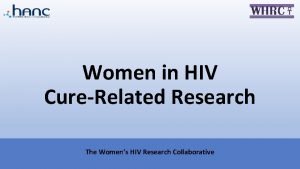Preventing HIV Among Women A Group and Community






















































































- Slides: 86

Preventing HIV Among Women: A Group- and Community- Level Approach Cynthia Prather, Ph. D. and Winifred King, Ph. D. Centers for Disease Control & Prevention National Center for HIV, STD & TB Prevention Division of HIV/AIDS Prevention Capacity Building Branch

Impact of HIV/AIDS n Black and Latino women represent 25% of all US women, yet accounted for 83% of AIDS diagnoses in 2003 n Heterosexual contact accounted for approximately 80% of the HIV cases reported among women in 2003

Impact of HIV/AIDS n Black women – In 2003, 7308 reported AIDS cases – Represented 68% of AIDS cases among all women n Latino women – In 2003, 1761 reported AIDS cases – Represented 16% of AIDS cases among all women


Social Moderators Associated with Risk Factors for HIV n Poverty n Sexually transmitted diseases n Powerlessness in intimate relationships n Lack of access to quality health care n Domestic Violence n Racism/Oppression

What is DEBI? n Diffusion of Effective Behavioral Interventions n www. effectiveinterventions. org n A national-level strategy to provide high quality training and technical assistance on science-based, community- and group -level HIV interventions

Examples of “DEBI’s” Women n n RAPP SISTA Si. HLE* Wi. LLOW* MSM n n n Mpowerment Many Men, Many Voices POL General n Community PROMISE IDUs n Safety Counts Youth n n Street Smart Focus on Kids* Racial/Ethnic Groups n Voices/Voces HIV Positive n n Partnership for Health* Healthy Relationships Teens Linked to Care Holistic Harm Reduction

REQUESTS FOR SISTA TRAINING BY STATE as of 2002 (N=1336) VT ME WA MT ND MN OR ID WY WI SD NY PA MI IA NV NE UT CO CA AZ IL KS OK NM VA MO KY NC TN AR MS TX IN OH WV AL NJ NH MA RI CT DE MD DC SC GA LA FL 20> requests 10> requests 9< requests 0 requests AK HI Guam Puerto Rico U. S. Virgin Islands

SISTA Facilitators Trained through DEBI Project as of 2002 (N=668) VT WA ME MT ND MN OR ID WY WI SD IA NE NV IL UT CO CA AZ MI KS OK NM MO OH _ WV KY AR AL VA NC SC TN MS TX IN NY PA GA LA FL AK HI Guam Puerto Rico U. S. Virgin Islands NJ NH MA RI CT DE MD DC

The SISTA Project: A Peer-led Program to Prevent HIV Infection Among African American Young Adult Women

Background n Sisters Informing Sisters About Topics on AIDS Si n Peer-led, social skills training intervention for African American women, 18 – 29 years old n Developed by Gina Wingood and Ralph Di. Clemente n Designed for implementation in a community-based setting, to encourage consistent HIV risk reduction behaviors

Background n Originally implemented in 1993 in California with 128 heterosexually active women n Baseline participants were non IDU, non crackusing women. 78 % completed the 3 month follow-up. n Results indicate that a social skills training which is delivered in a community setting can positively affect condom use.

Background n Five weekly 2 -hour sessions that emphasize ethnic and gender pride, reduction in HIV risk-behaviors, sexual negotiation skills, and proper and consistent condom use n Utilizes the Theory of Gender and Power and the Social Cognitive Theory

Theoretical Framework Social Learning Theory Premise n People need information (such as HIV riskinformation), social skills and behavioral skills and norms to apply risk-reduction strategies. n People are more likely to adopt a behavior when given the opportunity to learn about the behavior.

Theoretical Framework Social Learning Theory Behavior change is dependent upon a belief by the individual that they can successfully perform the skill, have confidence to use skills and apply knowledge, and anticipate that the outcomes will be beneficial.

Theoretical Framework Social Learning Theory and SISTA n Historically, women learn about life and how to cope with life’s challenges by having supportive relationships with other women. n These interactions, connections, and friendships are important sources of inspiration and evolve into a sense of sisterhood.

Theoretical Framework Theory of Gender and Power Premise n Gender inequality manifests itself in power imbalances and affects women’s ability to navigate through social and sexual environments.

Theoretical Framework Theory of Gender and Power Gender and power can contribute to a woman’s willingness to adopt and maintain sexual riskreduction strategies within heterosexual relationships as it pertains to: – – – Her perception of power (or lack of power) Her commitment to the relationship Her role in the relationship n Ability to maintain feminine role

Theoretical Framework Theory of Gender and Power Accounts for sexualizing aggressive males, though stigmatizing aggressive females (i. e. , making women feel they are not feminine)

Theoretical Framework Theory of Gender and Power 1. Structure of Cathexis: Cultural biases that oppress women, emotional influences and traditional gender norms enhance their vulnerability to HIV.

Theoretical Framework Theory of Gender and Power 2. Division of Power: Controlling women’s sexuality, (dating violence), devaluing women (negative media images), and silencing women (encouraging passive communication) enhances their vulnerability to HIV.

Theoretical Framework Theory of Gender and Power 3. Division of Labor: Limited access to information and economic resources enhances their vulnerability to HIV.

Overall Goals of SISTA n Increase safer sex behaviors, such as consistent condom use n Strengthen mediators of safer sex

Core Elements 1. Conduct small group sessions to discuss the session objectives, model skills development, role play women's skills acquisition and address the challenges and joys of being an African American woman. 2. Utilize skilled facilitators to implement SISTA group sessions.

Core Elements 3. Utilize cultural and gender appropriate materials to acknowledge pride, enhance self worth in being an African American woman (e. g. , use of poetry, artwork by African American women). 4. Train women in sexual assertion skills, so that they can both demonstrate care for partners and negotiate safe behaviors.

Core Elements 5. Teach women proper condom use--SISTA is designed to foster positive attitudes and norms towards consistent condom use and provide women the appropriate instruction for placing condoms on their partner. 6. Discuss cultural and gender triggers that may make it challenging for women to negotiate safer sex. 7. Emphasize the importance of partner involvement in safer sex--the homework activities are designed to involve the male partner.

Key Characteristics n Can be adapted for various populations n Facilitator driven n Culturally Competent n Covers a variety of topics

“EFFECTIVE” FACILITATOR

How Does It Work? Procedures n The intervention components include: – – – n Group discussion and lectures Behavioral Skills practice Role-play Safer sex communication Prevention video Home-work exercises The group level intervention consists of five 2 hour weekly group sessions and 2 booster sessions

SISTA Sessions n Session 1: Ethnic/Gender Pride n Session 2: HIV/AIDS Education n Session 3: Assertiveness Skills Training n Session 4: Behavioral Self-Management Training n Session 5: Coping

Session 1: Ethnic/Gender Pride n The facilitator generates a discussion about what it means to be an African-American, a woman, having pride in oneself and valuing oneself.

Session 2: HIV/AIDS Education n This session provides basic information about HIV/AIDS transmission; addresses myths and misconceptions about AIDS; and attempts to raise the women’s HIV risk awareness.

Session 3: Self Assertiveness Training n This session enhances assertiveness skills in the effort to address difficulties in dealing with partner pressure to engage in unsafe practices. It also teaches communication and negotiation skills required to initiate and implement safer practices.

Session 4: Behavioral Self-Management n The goal of this session is to decrease participants’ anxiety about condom use, demonstrate and role-play how to use and eroticize condom use and discuss reasons women don’t insist upon using condoms.

Session 5: Coping n This session serves as a review of the techniques and information from the previous sessions, teaches methods of dealing with alcohol and safer sex and examines coping with negative partner responses regarding safer sex practices.

Booster Sessions n Booster Session 1 – held two months after the intervention – Discussion – how can the intervention be strengthened? Are we using our skills? Challenges? – Design graduation ceremony w/ participants n Booster Session 2 – held four months after the intervention – Additional Questions – Graduation Ceremony

The SISTA Project Motto SISTA Love is Strong, SISTA Love is Safe, SISTA Love is Surviving!

RAPP: A Community-based Peer Outreach Program to Help Women and their Partners Reduce their Risk for HIV Infection

Background n RAPP is a research based intervention that Family Health Council, Inc. conducted in Pittsburgh, PA from 1991 through 1996 in four public housing communities. n RAPP was part of a five-year community-level demonstration study that was funded by CDC. n This study is formally known as the HIV Prevention in Women and Infants Demonstration Projects (WIDP).

Background n Proven successful with: – African Americans – Pittsburgh, PA – Latinas & Erotic Dancers – Portland, OR – Crack using women – Philadelphia, PA

Background n Baseline risk behaviors: – Having unprotected sex – IDU – Multiple sex partners – Partners of IDUs

RAPP Results n Results indicate that women who were exposed to the intervention: – Initiated condom use with their steady partners – Negotiated condom use with steady and casual partners n Women at very high risk (sex workers) were more likely to use condoms consistently with both steady and casual partners

What Makes RAPP Different from Most Interventions for Women?

Community Level Intervention Seeks to change the attitudes, norms and values, as well as the social and environmental context of risk behaviors of an entire community/target population

Key Aspects of CLI n Promote community mobilization and empowerment n Acknowledge the importance of peer norms and influence n Strives to influence the community norms, attitudes and beliefs about risk behaviors

…by Using n Gatekeeper (Outreach Specialist) n Persuasive communications – Role model/peer experience stories n Peer Networkers n Social reinforcement (peer outreach) & Stage-based encounters

…by Using n Skills-building (small group activities) n Prevention materials distribution – Condoms or bleach kits n Referrals to HIV Testing & Counseling site n Referrals to social services

Overall Goals of RAPP n To increase consistent condom use by reproductive age women and their partners n To change community norms so that practicing safer sex is viewed as the normal thing to do n To involve as many people in the community as possible.

Stages of Change Theory n Posits that individuals change their behavior in stages over time. The theory’s framework describes the typical stages a person progresses through when changing behavior.

Diffusion of Innovation Theory n A new idea or practice that is circulated and accepted among a group or community over time n Behavior is promoted by well respected key gatekeepers within a given community n People are more likely to adopt a behavior if influential community leaders embrace and adopt that behavior

Social Learning Theory n People need information (such as HIV riskinformation), social skills and behavioral skills and norms to apply risk-reduction strategies. n People are more likely to adopt a behavior when given the opportunity to learn about the behavior.

Social Learning Theory n Behavior change is dependent upon an individual’s belief that s/he can successfully perform the behavior – Confidence to use skills and apply knowledge – Anticipate that outcomes will be beneficial (Bandura, 1986, 1991).

Core Elements Peer Network n Community Network n Staged-based Encounters n Role Model Stories n Small Group Activities n

Relationship Between Core Elements and Theoretical Foundation of RAPP Peer Network Stage Based Encounters n. Diffusion of innovation n. Social learning theory n. Stage of change n. Social learning theory n. Social Role Model Stories learning theory n. Stage of change n. Diffusion of innovation Community Network n. Diffusion Small Group Activities n. Social of innovation learning theory

Community Mobilization Definition: n An effort to enable community members to direct and own the intervention through their continual input and personal participation

Purpose of Community Mobilization n Use the existing social networks to support behavior change (small group activities, peer networks) n Draw attention to the role model stories and media message n Create opportunities for community involvement (peer and community networks) Create project identity: name and logo

Purpose of Community Mobilization n Create project identity: name and logo n Use the power of the community to initiate and maintain behavior change (small group activities, peer networks) n Empower community members to improve their health and well-being

Implementation of RAPP

– Duration: 1 -9 months – Orient agency to project (RAPP video) – Present project and get approval from community decision makers – Identify and equip a central work location – Hire & train an outreach specialist and other staff – Conduct community assessment

Community Assessment Key Participant Interviews Focus Groups n Getting to know the target community n Key Participant Interviews n Conducting Focus Groups

Community Assessment n Important for identifying and describing structural, environmental, behavioral, and psychological facilitators and barriers to HIV risk reduction. n To develop a tailored intervention

Project Staffing n Outreach Specialist – Conducting stage-based encounters – Supervising peer network outreach – Conducting community networking – Conducting small group activities – Project monitoring & record keeping

Project Staffing n Peer Network Members – Talk to people and distribute role model stories, other information and condoms – Conduct stage-based encounters (optional) – Track outreach activities – Supply materials to members of community network

– Duration: 9 -18 months – Begin peer networking and weekly peer debriefings – Recruit community network & distribute materials to network members – Train staff & volunteers to conduct stage-based encounters – Conduct stage-based encounters

– Develop outlines for small group activities & recruit hosts – Hold small group activities – Develop, adapt or reproduce role model stories – Track activities – Make adjustments – Implement evaluation activities

Peer Network Recruitment Made up of people from the community who work several hours a week to talk to women and men about HIV prevention and related issues. They also distribute condoms, rolemodel stories, and other educational materials.

VIDEO

Community Network Recruitment A cadre of local businesses, organizations and agencies that support the intervention’s goals in a variety of ways, including displaying and/or distributing role model stories and other educational materials and sponsoring project activities.

1. Making contacts 2. A few simple questions to find out if people are using condoms. Staged-Based Encounters 3. Determining the person’s stage. 4. Responding in a way that gives information, encouragement and/or positive feedback specific to the person’s stage of behavior change. 5. Handing out role model stories, condoms and appropriate referrals.

Small Group Activities To give people an opportunity to learn about HIV prevention: – Safer sex gatherings - HIV 101 presentations

VIDEO

– Printed short stories based on interviews with people about their decision to change their behavior. Role Model Stories – People in different situations and stages of change tell about experiences that made them think about, start, or continue using condoms.

Purpose of Role Model Stories n Model risk reduction behavior n Gives the reader a sense of community norms or values n Able to guide readers through stages of behavior change or encourage movement

– Duration: Months 18 – onward – – Continue project activities Continue tracking all activities – Get community feedback – Use evaluation data to make mid-course corrections and enhance implementation – Seek any additional funding

Adapting and Tailoring

What is “Adaptation” and “Tailoring”? n n Involves making changes to an intervention or set of interventions to modify components WITHOUT changing or dropping core elements. Changes made: – – To whom activities are delivered Where those activities are delivered When those activities occur What happens during those activities

What is “Adaptation” and “Tailoring”? (continued) EXAMPLES: n Using RAPP with male and female migrant farm workers (Adaptation) n Conducting stage based encounters in a community center when members of immigrant communities congregate (Adaptation)

What is “Adaptation” and “Tailoring”? (continued) n Use community network member sites for quarterly rapid testing (Tailoring) n Incorporate messages about knowing your status into role model stories or stories that are devoted to knowing your status (Tailoring) n Provide an overview of SISTA (or other groups) during small group activities and give participants an opportunity to enroll (Tailoring)

What is “Adaptation” and “Tailoring”? (continued) n Adaptation represents an effort to attend to BOTH program fidelity during the complex process of program implementation n Appropriate adaptations are critical to successful, sustained implementation of science-based prevention interventions

Integration of SISTA with RAPP Example Planning Process Integration Activities Recruit and provide information about SISTA Incorporate themes of gender and ethnic pride RAPP Activities Peer Networking Stage Based Encounters Role Model Stories Implement SISTA Sessions Small Group Activities Advertise SISTA Meetings Community Networks Affect these risk and protective factors Which influence this behavior Perception of risk Consistent condom use by women and their partners in target communities Condom access Condom information Change in Peer Norms Condom use skills Self validation Peer support Condom use norms Overall Goal To decrease the incidence of HIV in the target communities

Benefits Of Integrating SISTA with RAPP n Empowers women, their partners, families and communities n Provides a strong support network n Supports positive behavior changes over time n Reinforces new community norms around condom use n Greater achievement of goals

7 Steps for Adapting and Tailoring Interventions 1. Who? Understand the Target Populations – – 2. Risk behaviors Influencing Factors What? Understand the Intervention – – – Risk behaviors targeted by intervention Core elements and key characteristics Theoretical constructs of intervention

7 Steps for Adapting and Tailoring Interventions 3. Where and Who? Agency Capacity Assessment – Location of intervention activities 4. community center vs. house) – Intervention staff Does it match? (i. e. Matching Target Population, Intervention, and Agency – Determine if targeted behaviors match those – the intervention is designed to affect Determine if influencing factors are consistent with theoretical constructs on which the intervention is based

7 Steps for Adapting and Tailoring Interventions 5. How and When? Preparation – – – 6. Funding Timeline Staff expectations Do it! Implement the intervention n Follow newly developed implementation plan reflecting adaptation

7 Steps for Adapting and Tailoring Interventions 7. Is it working? Evaluation – – – Conduct process monitoring and process evaluation Conduct outcome monitoring Compare changes to those realized by the intervention study Make appropriate adjustments Stabilize program Monitor and document process and outcomes

? ? ? QUESTIONS ? ? ? ?
 Chapter 24 lesson 2 preventing and treating stds
Chapter 24 lesson 2 preventing and treating stds Chapter 9 lesson 2 resolving conflicts
Chapter 9 lesson 2 resolving conflicts Chapter 14:2 preventing accidents and injuries
Chapter 14:2 preventing accidents and injuries Chapter 9 resolving conflicts and preventing violence
Chapter 9 resolving conflicts and preventing violence Chapter 13:2 preventing accidents and injuries
Chapter 13:2 preventing accidents and injuries Chapter 20 preventing kitchen accidents
Chapter 20 preventing kitchen accidents Chapter 16 preventing infection
Chapter 16 preventing infection Preventing kitchen accidents worksheet
Preventing kitchen accidents worksheet How do empathy theories prevent discrimination
How do empathy theories prevent discrimination Chapter 4 preventing injuries through fitness
Chapter 4 preventing injuries through fitness Chapter 15 preventing infection
Chapter 15 preventing infection Preventing hand injuries
Preventing hand injuries Work comp puncture
Work comp puncture Preventing ageing unequally
Preventing ageing unequally Which is mainly responsible for preventing erosion
Which is mainly responsible for preventing erosion Chapter 25 sexually transmitted infections and hiv/aids
Chapter 25 sexually transmitted infections and hiv/aids Chapter 24 sexually transmitted diseases and hiv/aids
Chapter 24 sexually transmitted diseases and hiv/aids Triệu chứng nhiễm hiv
Triệu chứng nhiễm hiv Where did hiv come from
Where did hiv come from Test wiedzy o hiv i aids z odpowiedziami
Test wiedzy o hiv i aids z odpowiedziami 10 steps of index testing
10 steps of index testing Program nasional penurunan angka kesakitan hiv
Program nasional penurunan angka kesakitan hiv Phdp in hiv
Phdp in hiv Chii chinonzi hiv
Chii chinonzi hiv Hcv window period
Hcv window period Dot
Dot Iris hiv
Iris hiv Hiv
Hiv Hiv risk factors
Hiv risk factors Asante hiv-1 rapid recency assay
Asante hiv-1 rapid recency assay Fiebig hiv
Fiebig hiv Ephi ethiopia
Ephi ethiopia Triệu chứng nhiễm hiv
Triệu chứng nhiễm hiv Basic hiv course
Basic hiv course Stakeholders in hiv prevention
Stakeholders in hiv prevention Hiv treatments
Hiv treatments Causative organism of hiv/aids
Causative organism of hiv/aids What does hiv stand
What does hiv stand What does hiv stand
What does hiv stand Hiv test window period
Hiv test window period What does hiv diarrhea look like
What does hiv diarrhea look like Procentowe ryzyko zakażenia hiv
Procentowe ryzyko zakażenia hiv Hiv adalah
Hiv adalah Hiv lifecycle
Hiv lifecycle Hiv pencere dönemi
Hiv pencere dönemi Hiv lifecycle
Hiv lifecycle Hiv
Hiv Chapter 17 oral pathology
Chapter 17 oral pathology Incubation period of hiv
Incubation period of hiv Resposta imune inata
Resposta imune inata Vidas hiv duo ultra package insert
Vidas hiv duo ultra package insert Profilaksis pasca pajanan hiv
Profilaksis pasca pajanan hiv Ott a messze földön árván hontalan
Ott a messze földön árván hontalan Hiv patologia
Hiv patologia Hiv life cycle
Hiv life cycle Most complex characters evolve
Most complex characters evolve Herpes syntom
Herpes syntom Hiv roga lakshana
Hiv roga lakshana Negative hiv test result
Negative hiv test result Hiv
Hiv Hiv
Hiv Hiv
Hiv Hiv
Hiv Ciclo do hiv
Ciclo do hiv Phagocytosis ap bio
Phagocytosis ap bio Hiv siv
Hiv siv Hiv stays alive in dried blood
Hiv stays alive in dried blood Nsradio
Nsradio Sex24x
Sex24x Procentowe ryzyko zakażenia hiv
Procentowe ryzyko zakażenia hiv Hiv
Hiv Abcde hiv
Abcde hiv Simon collins hiv
Simon collins hiv Hiv test
Hiv test Objawy hiv
Objawy hiv Choroby wskaznikowe aids
Choroby wskaznikowe aids Types of hiv counselling
Types of hiv counselling Hiv from oral
Hiv from oral How does hiv get into the urethra
How does hiv get into the urethra Stadium hiv
Stadium hiv Notifikasi pasangan adalah
Notifikasi pasangan adalah Stadium hiv
Stadium hiv Virus hiv
Virus hiv Retrovrus
Retrovrus Dr shabani
Dr shabani Brainpop
Brainpop Hiv
Hiv





